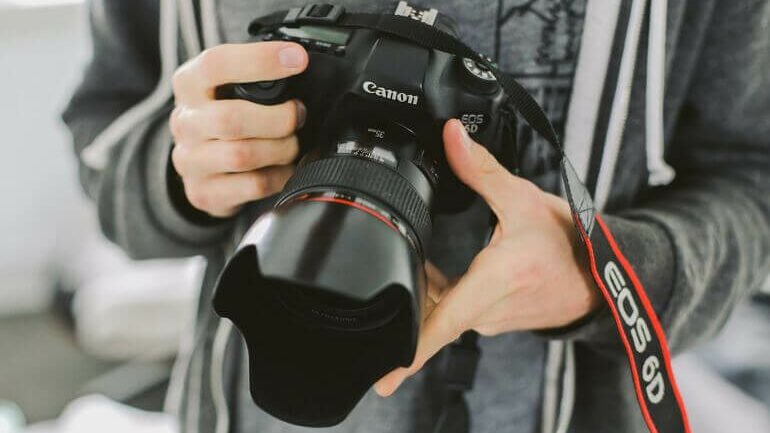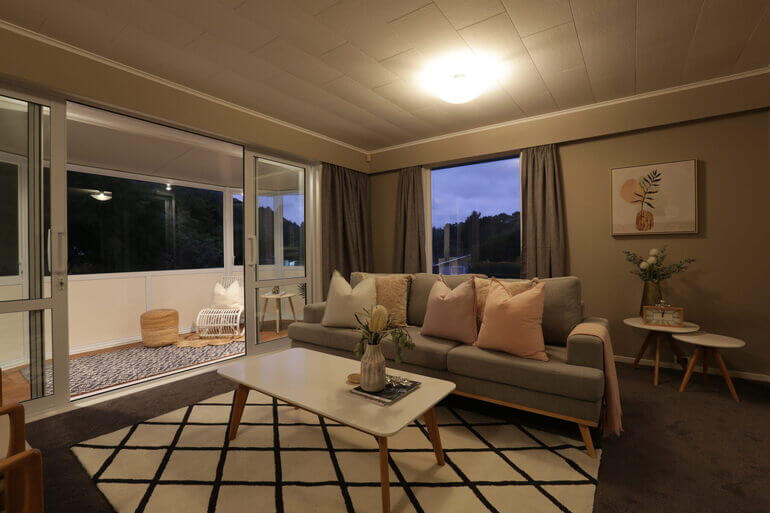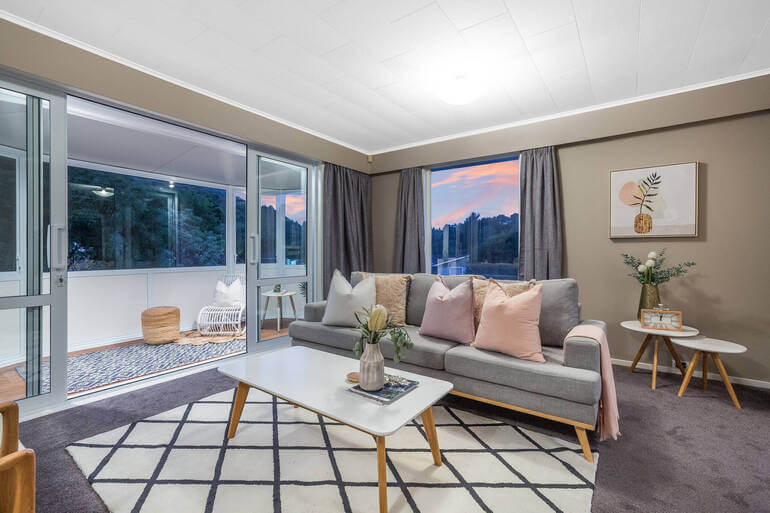For real estate professionals, the old adage ‘a picture is worth a thousand words’ holds truer than ever. With the majority of home buyers turning to the internet at some point during their search (an astounding 99% in 2022), high-quality photography can make the difference in getting potential clients through the door.
In this article, we’ll reveal 5+ secrets that can elevate your real estate photography to capture not just a property, but the hearts and imaginations of viewers.
Let’s start by taking a look at the importance of captivating photography when marketing and selling real estate.
The Importance of Captivating Real Estate Photography


The digital landscape has made visual appeal an indispensable aspect of real estate marketing.
According to recent studies, 61.3% of brokers believe high-quality photography is crucial for selling homes.
This aligns with the fact that 83% of buyers said pictures are very important in helping them choose which homes they will visit.
So whether you’re a professional real estate photographer or an agent looking to improve your property listings, understanding the nuances of great photography is key.
It’s not just about taking pictures; it’s about creating a narrative that entices and engages.
6 Secrets to Creating Captivating Real Estate Photos
With this in mind, let’s delve into 6 secrets to creating captivating real estate photography that’s sure to impress potential buyers and sell homes faster.
Secret 1. Using the Right Equipment and Gear
The foundation of any great real estate photograph is the equipment that it’s taken with.
Invest in a Professional Camera

Investing in a capable DSLR or mirrorless camera and a few essential accessories can transform mundane pictures into compelling shots that sell.
In general, DSLR cameras are the favored choice for real estate photography. These cameras allow the photographer the greatest flexibility, ease of use, and settings options.
DSLR cameras produce accurate shots that help potential buyers see the full layout of a home, thereby getting a better feel and sense of the property.
Mirrorless cameras are also good options and offer several advantages like smaller sizes, faster shooting speed, and better video capabilities.
However, they also have some disadvantages, such as shorter battery life, limited lens selection, and higher price points.
Use Stabilizing Camera Equipment

When it comes to camera equipment, a sturdy tripod is non-negotiable for capturing sharp, evenly aligned photos. This avoids camera shakes and blurry images.
Additionally, a wide-angle lens can help capture more of the room, making spaces seem larger and more inviting.
Recommended Lenses for Real Estate Photography

For traditional DSLRs, lenses like the Canon EF 17-40mm f/4L and the Nikon 16-35mm f/4G are popular choices, offering good image quality and a wide field of view.
Mirrorless cameras are not to be overlooked either, with lenses like the Sony FE 12-24mm f/4 G they can produce stunning results.
Secret 2. Knowing How to Leverage Lighting
Lighting can truly make or break a photograph, especially when it comes to showcasing interior and exterior spaces.
Knowing when to use natural light and when to augment it with artificial can lead to exceptionally balanced shots.
Natural Light vs Artificial Lighting


Natural light is a photographer’s best friend when it’s soft and diffused; think of the gentle glow half an hour after sunrise or before sunset called the golden hour.
When natural light isn’t available, a combination of flash units with softboxes or umbrellas, diffused LED panels, and reflectors can create even, natural-looking artificial light indoors.
Achieving Balanced Lighting in Interior and Exterior Shots


For interiors, start by turning on all available lights to reduce the amount of artificial light you need to add.
Focus on directing light into dark corners and bouncing it off walls or ceilings to soften the shadows.
When shooting exteriors, consider the natural direction of the sunlight and supplement with flash to illuminate shaded areas.
Balancing interior and exterior light can be tricky, but is essential to show off the property in its best light.
Now, let’s take a look at the most important aspect of all, which is post-processing and learning how to edit real estate photos to make them stand out from the competition.
Secret 3. Performing Twilight Editing
Twilight photography, known for its deep blue and purple romantic skies and the warm, inviting glow of interior lights, can evoke an emotional response from viewers.
While capturing the perfect twilight is an art in itself, editing can help perfect the dreamy scenes.
The Power of Twilight Real Estate Photography


Twilight shots stand out in real estate listings, as they articulate the property’s potential for warmth and homeliness.
The transition of a property’s look from day to evening can be captivating, and effectively convey that ‘homey’ feeling, particularly to potential homebuyers.
How to Edit Twilight Images
Post-processing software like Lightroom or Photoshop can help highlight the strengths of a twilight image.
Techniques such as color temperature adjustments, saturation boosts, and the careful use of graduated filters can enhance the natural beauty of the sky and emphasize the golden hours.
To learn how to do this, check out our video tutorial on how to edit a day to dusk image for real estate photo editing:
Have You Ever Thought To
Outsource Photo Editing?
Try it today with 10 free edits from three professional photo editors.
Secret 4. Leveraging Virtual Staging
Empty homes don’t leave much to the imagination, and even the most beautifully designed space can look plain without furniture and decor.
Virtual staging is a game-changer, allowing you to fill empty or outdated rooms with tasteful furnishings and décor.
It even lets you perform virtual renovations and improvements to the landscaping.
Leveraging Virtual Staging to Stage Empty Spaces


Virtual staging services like PhotoUp and other software have made it easier than ever to enhance interior and exterior spaces with digital furniture, art, and even plants.
PhotoUp’s virtual staging library has 11 different designs, 20 room types, and 21 accessory types to choose from, including the following styles:
- Mid-Century Modern
- Scandinavian
- Coastal
- Farmhouse
- Modern
- American
- Industrial
- Hamptons
- Luxury
- Southwestern
- And Commercial
This not only allows you to stage a space without the time and physical effort involved but also can help prospective buyers envision themselves living in the home.
How to Virtually Stage Your Real Estate Photos
When virtually staging, choosing quality furnishings that suit the style and size of the room is important.
Ensure that the digital items integrate seamlessly with the lighting and perspective of the original photo to create a realistic look.
PhotoUp Virtual Staging Demo
To learn how to use PhotoUp’s virtual staging service and virtually stage your images in less than 48 hours, check out our virtual staging demo:
Secret 5. Doing Advanced Object Removal
An often-overlooked secret to captivating real estate photography is the removal of unwanted objects.
Even the tiniest details can adversely affect the viewer’s perception of a property, which is where strategic editing comes in.
The Importance of Removing Distractions and Clutter


A messy room, personal items, or even a stray power cord can be distracting in a photo.
Eliminating these elements can help maintain focus on the property’s selling features, rather than its current occupant’s belongings or the presence of clutter.
How to Remove Unwanted Objects in Your Images
In post-processing, you can use the Cloning Stamp and Healing Tools to remove unwanted objects and declutter your images.
But remember to always strive to maintain the integrity of the space and avoid misleading edits.
To learn how to remove unwanted objects, check out our blog post on 4 simple editing techniques to remove objects in interior photos.
Or watch this video tutorial on how to remove cords in Photoshop:
High-Quality & Consistent
Real Estate Photo Editing
Hire a dedicated editor with performance metrics from $7/hour.
Secret 6. Making Sky Replacements
The sky is a constant in any exterior real estate photograph. A dull, overcast sky can detract from the beauty of the home’s exterior.
Sky replacement can provide that ‘pop’ and allure that a vibrant, blue sky brings.
The Power of Sky Replacements


A bright, sunny sky is the ideal complement to a well-lit exterior shot, as it adds a sense of openness and life.
However, weather conditions aren’t always cooperative. Luckily, sky replacement gives you control over the weather and helps convey the potential beauty of the property’s surroundings.
How to Do a Sky Replacement in Photoshop
To learn how to do a sky replacement in Photoshop, watch this video tutorial:
Pay careful attention to the final result, aiming for realism rather than an obvious digital alteration.
And there you have the secrets to creating captivating real estate photography!
Conclusion


Real estate photography is both an art and a marketing tool that can greatly influence a property’s appeal.
These six secrets offer a roadmap for photographers and agents looking to improve their photography skills and, in turn, bolster their real estate offerings.
Continuously practice and experiment with these techniques, and review your work critically to identify areas for growth.
Over time, your photography will not only capture what a property looks like, but what it feels like to be there, setting you apart in the competitive real estate market.
But if you don’t have the time to practice and want to ensure top-notch real estate photography all the time, you should consider outsourcing your editing to PhotoUp.
With PhotoUp’s team of professionals, you can get help with anything from basic brightness and color corrections to HDR editing, twilight or day-to-dusk conversions, virtual staging, virtual house tours, and much more.
So sign up for a free PhotoUp account today, and let PhotoUp help you create captivating real estate photos that will impress your clients!
Best of all, when you sign up for an account, you’ll receive a bonus of 10 free credits to use however you please.
We hope this blog post provided some great tips on creating captivating real estate photography. Before you go, you may also want to check out the following resources:






